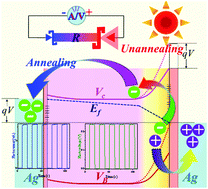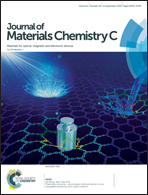A surface state-controlled, high-performance, self-powered photovoltaic detector based on an individual SnS nanorod with a symmetrical electrode structure
Abstract
With the decreasing size of materials to the nanoscale, the surface effect plays a critical role in device performance. Herein, an individual SnS nanorod-based photodetector shows excellent sensitivity, selectivity and responsivity, which can be modulated controllably via the operation bias, illumination intensity and annealing temperature. Moreover, its surface state-governed photovoltaic mechanism is proposed. For the two-terminal device, two back-to-back diodes can be formed due to the presence of a surface barrier. At a low operation voltage, the surface barrier dependence of the photodetector results in a wideband response in the ultraviolet (UV) to near infrared wavelength range with a large photo-to-dark current ratio. However, at a high operation voltage, the surface barrier associated with the negative electrode disappears due to Fowler–Nordheim tunneling. Accordingly, the bulk material dependence of the photodetector results in a narrowband response to light close to the SnS bandgap accompanied with a large dark current. Moreover, the photodetector shows a negative photoresponse to solar-blind UV light that originates from its high absorption coefficient, where short-wavelength light induces the excitation of trapped electrons located in the surface space charge region. Based on the tunable principle of nanostructure surface states, a self-powered photovoltaic photodetector with a symmetrical structure is successfully realized by asymmetrically annealing the two electrode ends. At zero bias, it shows a relatively large photogenerated voltage and current under weak incident light illumination. The operation bias, illumination intensity and annealing temperature govern its photoresponse via the adjustment of its surface states. Therefore, this nanostructure-based photovoltaic photodetector with superior performance will have important applications in new-generation optoelectronic devices.



 Please wait while we load your content...
Please wait while we load your content...